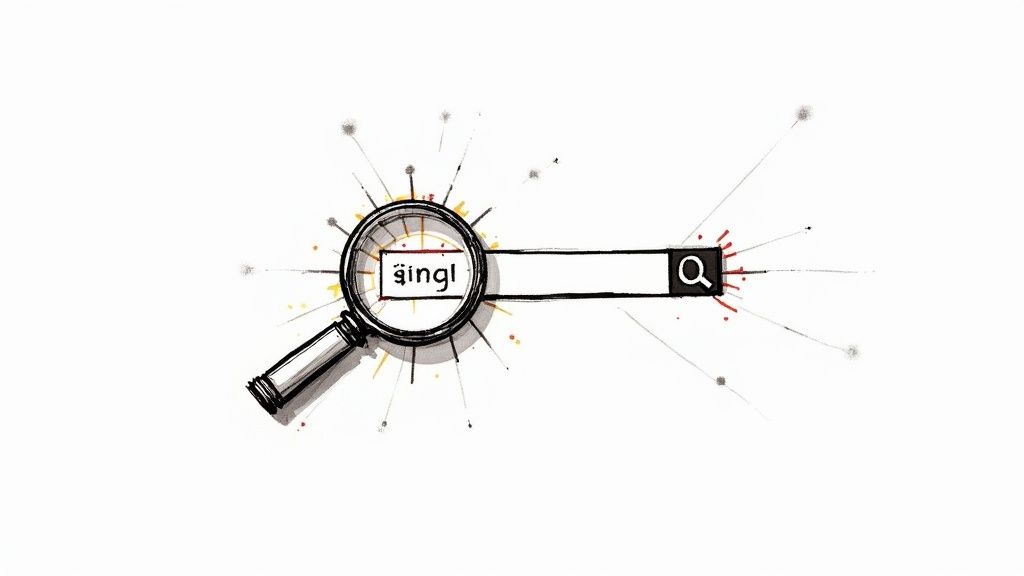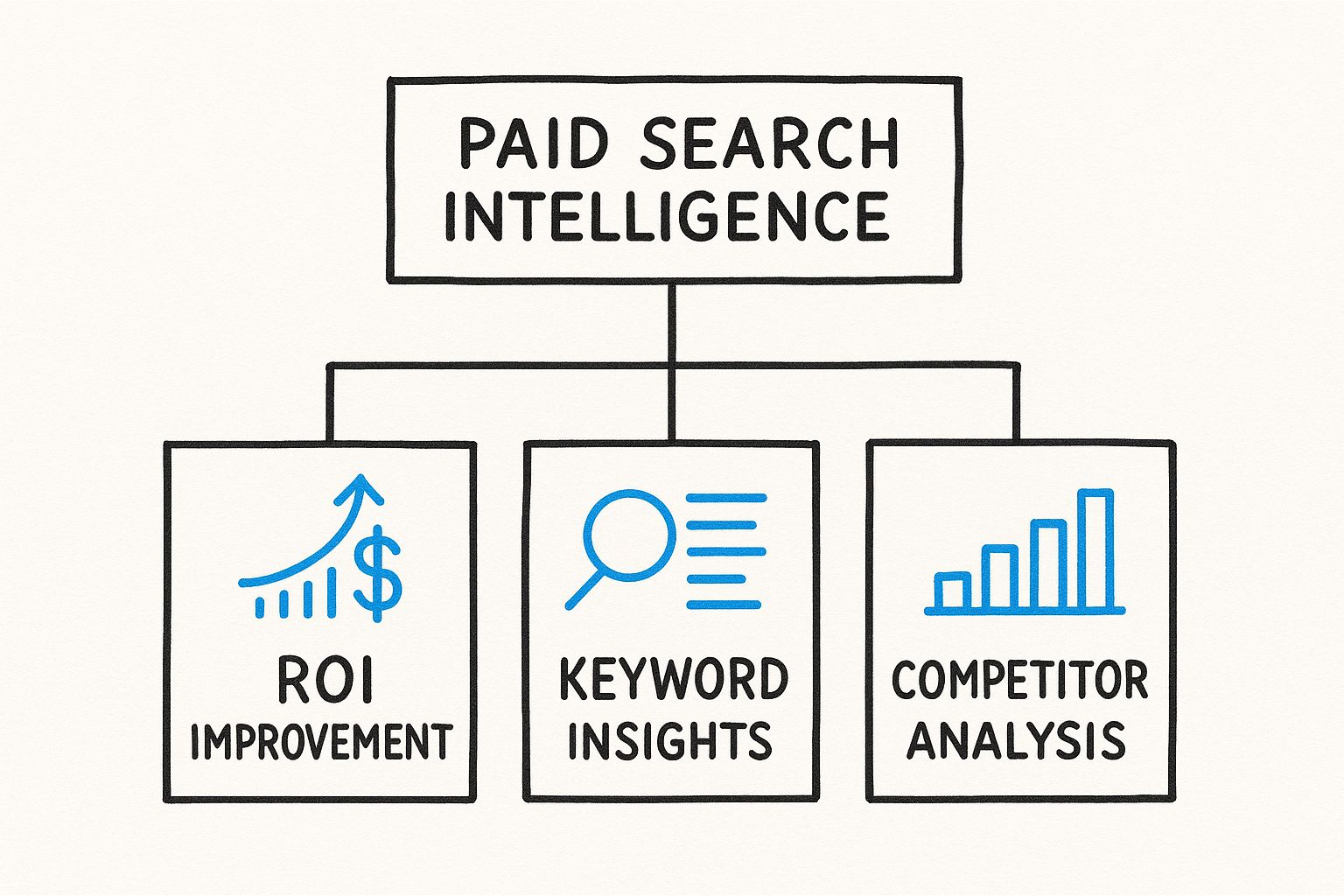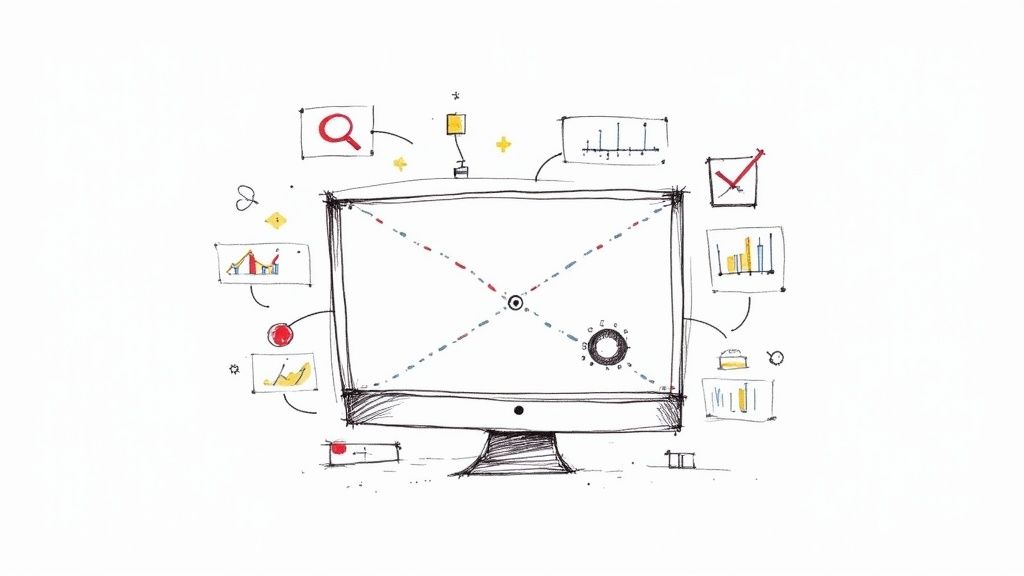Master Paid Search Intelligence for Smarter PPC Campaigns

Maxime Dupré
10/6/2025

Paid search intelligence is all about gathering the right data and using it to make smarter, more proactive decisions for your ad campaigns. It's a huge leap beyond just tracking your own metrics. We're talking about folding in competitive analysis, deep audience behavior insights, and market trend data to get the full picture of the advertising world you're playing in.
What Is Paid Search Intelligence

Think of it this way. Traditional pay-per-click (PPC) management is like using an old-school paper map to get around a new city. Sure, it shows you the streets and where you are, but that’s about it. You have no clue about the massive traffic jam up ahead, the sudden road closure, or the brand-new shortcut that just opened. You’re stuck reacting to problems only after you run right into them.
Paid search intelligence, on the other hand, is your real-time GPS. It’s feeding you live traffic updates, rerouting you around accidents, and constantly finding the best path forward. This approach completely changes how you run your campaigns by giving you a dynamic, 360-degree view of the entire playing field, not just your own little corner of it.
Moving From Reactive To Proactive
This is a fundamental shift in mindset. You stop making reactive tweaks based on what happened last week and start building proactive strategies based on solid data. It’s about digging deeper to understand not just what happened, but why it happened—and, more importantly, what’s likely to happen next.
When you start blending different data sources, you can see market shifts and competitor moves coming before they ever hit your bottom line.
The core of this approach really comes down to a few key pieces:
- Competitive Analysis: This means keeping a close eye on your competitors. What keywords are they bidding on? What does their ad copy look like? How aggressive are their bidding strategies? You're looking for their strengths and, even better, their weaknesses.
- Audience Insights: Go beyond simple demographics. You need to get into the heads of your customers to understand their intent, how they search, and what their journey looks like from start to finish.
- Market Trend Data: Stay on top of industry-wide changes, seasonal spikes in demand, and new keywords that are just starting to bubble up. This is how you get ahead of the curve.
- AI-Driven Predictions: Using machine learning to forecast campaign performance, adjust bids automatically, and uncover new pockets of growth you might have otherwise missed.
The real goal of paid search intelligence is to turn messy, raw numbers into actionable data for smarter marketing. It’s about turning those insights into a real, measurable edge over everyone else.
To show just how different this is, let's break down the shift from the old way of doing things to an intelligence-first approach.
From Traditional PPC to Paid Search Intelligence
| Aspect | Traditional PPC Management | Paid Search Intelligence |
|---|---|---|
| Focus | Internal performance metrics (CTR, CPC, Conversions) | Holistic view (internal data + competitor & market data) |
| Approach | Reactive (adjusting based on past results) | Proactive (anticipating changes and opportunities) |
| Data Sources | Primarily Google Ads & Analytics | Multiple sources (ad platforms, competitive tools, trend data) |
| Decision Making | Based on historical data and intuition | Data-driven, backed by predictive models and real-time insights |
| Competitive Edge | Limited to optimizing own campaigns in isolation | Sustainable advantage by outmaneuvering competitors |
This table really highlights the evolution from just "managing" campaigns to truly leading the market with strategic, forward-thinking decisions.
The Power Of A Holistic View
At its core, paid search intelligence is built on a solid foundation of competitive intelligence. If you want to dive deeper into that specific concept, our guide on what is competitive intelligence is a great place to start. When you combine this outward-looking analysis with your own internal performance data, you create an incredibly powerful feedback loop.
This complete view lets you answer the tough questions that basic PPC reports can't touch. Questions like, "Which valuable keywords are my competitors completely ignoring?" or "How is that recent shift in consumer sentiment affecting ad performance across my entire industry?"
This is the foundation. Understanding this intelligence-driven mindset is the first step toward consistently outperforming your competition.
The Three Pillars of Search Intelligence
If you want to build a paid search strategy that actually works, you can't just operate in a silo, tweaking your own campaigns and hoping for the best. A powerful, long-lasting approach is built on three distinct but deeply connected pillars of intelligence.
Think of it like a three-legged stool—kick one leg out, and the whole thing topples over. To stay balanced and see clearly in the crowded world of paid search, you need all three.
These pillars are Competitive Intelligence, Audience Intelligence, and Market Intelligence. Each gives you a different, vital perspective. Mastering them is what separates the advertisers who are always playing catch-up from the ones who are consistently two steps ahead. When you blend insights from all three, you stop reacting and start leading.
This is all about creating a powerful feedback loop where competitor insights sharpen your keyword strategy, which then drives better campaign performance and, ultimately, a much healthier ROI.

Pillar 1: Competitive Intelligence
The first pillar, Competitive Intelligence, is all about looking over your rival's shoulder to figure out their playbook. What are they doing, right now, to win the clicks and sales you’re also fighting for? This isn't about blindly copying them. It's about spotting their strengths, finding their weak spots, and identifying the gaps in the market they've completely ignored.
Imagine what you could do if you understood:
- Their Keyword Strategy: What terms are they betting on? Even better, which high-value keywords have they missed?
- Their Ad Copy and Messaging: What story are they telling? Are they leading with price, quality, or a specific feature?
- Their Budget Allocation: Where are they pouring their money? A sudden spending spike often points to a new strategic focus or a campaign that's absolutely crushing it.
Tools that deliver this kind of data are no longer a "nice-to-have"; they're essential for getting a true feel for the competitive battlefield. By seeing what's working for them, you can reverse-engineer their success and find smart ways to outplay them for the most valuable search terms.
Pillar 2: Audience Intelligence
While competitive intelligence looks at your rivals, Audience Intelligence turns the lens back on the most important people: your customers. This is so much more than basic demographics. Real audience intelligence gets to the why behind every search.
What problem is someone actually trying to solve when they type that query? What are their hopes, fears, and frustrations?
When you can answer those questions, you can map out their entire journey. You can then craft ad copy and landing pages that speak directly to their needs at that exact moment. It’s how you create a smooth, persuasive path from their first click to the final conversion.
By understanding user intent, you can move from simply matching keywords to truly connecting with potential customers. This shift is critical for improving ad relevance, boosting Quality Scores, and ultimately lowering your acquisition costs.
Pillar 3: Market Intelligence
The final pillar, Market Intelligence, gives you that 30,000-foot view of your entire industry. It helps you see the bigger trends and shifts that affect everyone in your space, not just your closest competitors.
This is where you answer the big-picture questions:
- Monitoring Industry Trends: Are new technologies or regulations about to change how people search?
- Identifying Seasonal Demand: When do searches for your services naturally spike and dip throughout the year?
- Spotting Emerging Keywords: What new search terms are people starting to use before they hit your competitors' radar?
Having this broader context is crucial. The global paid search market is massive—valued at around USD 252.5 billion in 2025 and projected to hit USD 440.6 billion by 2030. With regions like Asia-Pacific holding a 39% revenue share, the ground is constantly shifting underneath us. If you want to learn more, you can explore details about this search engine market growth and what’s driving it.
Paid search intelligence is what helps you adapt to these changes and keep your strategies from becoming stale.
By weaving together these three pillars, you build a complete intelligence framework. You can see what competitors are doing, understand what customers truly want, and anticipate where the market is going next. This integrated view is the foundation for campaigns that don't just compete—they dominate.
Using AI to Predict Campaign Success

Artificial intelligence has officially crossed the line from a "nice-to-have" novelty into a must-have tool for any serious marketer. In the world of paid search, AI is completely rewriting the rulebook. It's shifting strategies from reactive tweaks to proactive, predictive plays that deliver seriously impressive results.
Think of it this way: managing bids manually is like trading stocks based on yesterday's newspaper. You have some information, but you're already behind. AI, on the other hand, is like a high-frequency trading algorithm that spots market shifts in real-time, making thousands of tiny adjustments to capitalize on opportunities before a human could even notice them.
This is the real power behind modern paid search intelligence. We're using machine learning not just to see what worked last week, but to forecast what will work next with surprising accuracy.
Automating Bids with Predictive Analytics
One of the most practical applications of AI is in automating the entire bidding process. Instead of poring over keyword data and manually setting bids, AI algorithms can analyze dozens of signals in the blink of an eye to decide the perfect bid for every single auction.
A clear-cut example of this is the sophisticated PPC bid management automation that’s now available. This isn't just a time-saver; it’s about hitting a level of granular precision that a person simply can't match.
These AI models are looking at factors like:
- Time of day and user location to bid up when conversions are most likely.
- Device type and browser to account for performance differences.
- Audience segments and past behavior to bid more on high-intent users.
- Competitor bidding patterns to react instantly to market changes.
This frees you up to focus on the big picture—like creative strategy and audience building—instead of getting lost in the weeds of daily bid management.
By sifting through massive amounts of data, AI learns to recognize the subtle patterns that come right before a conversion. It figures out what a "ready to buy" customer looks like and makes sure your ad is right there at that critical moment.
Supercharging Ad Creative with Generative AI
It's not just about bids. Generative AI is making a huge splash in creating and testing ad copy. Let’s be honest, manually writing and A/B testing dozens of ad variations is a grind that yields smaller and smaller returns.
Generative AI can spit out hundreds of unique headlines and descriptions in seconds.
This lets you test at a massive scale, quickly finding the exact messaging that clicks with different audience segments. You can accelerate your optimization cycle from weeks down to a matter of hours.
The global impact is undeniable. As AI makes ad targeting more efficient, the global AI software market is projected to hit USD 174.1 billion by 2025. While North America currently leads the charge with 54% of this investment, the Asia-Pacific region is on track to grow its share from 33% to 47% by 2030.
Uncovering Hidden Keyword Opportunities
AI-powered tools are also brilliant at sniffing out emerging keyword trends and untapped niches. By analyzing search queries and social media chatter in real-time, these systems can spot high-intent keywords before they get crowded and expensive.
This gives you a huge first-mover advantage, letting you capture valuable traffic while your competitors are still looking at last month's reports. It’s a proactive way to discover keywords that keeps you a step ahead. If you're exploring platforms for this kind of work, our business intelligence tools comparison offers a great overview of the options out there.
By weaving AI into your strategy, you’re doing more than just optimizing campaigns—you're building a predictive engine for success. It’s what lets you anticipate market shifts, truly understand your audience’s intent, and make smarter, data-backed decisions that give you a powerful edge.
Connecting Search Insights to Content Strategy
https://www.youtube.com/embed/16-dF2p0kKo
So you’ve built a brilliant ad campaign that’s driving a ton of clicks. That’s great, but it's a completely wasted effort if it leads to a weak or irrelevant landing page. This disconnect—the gap between the ad's promise and the content's delivery—is where so many paid search strategies fall apart, leaking budget and frustrating potential customers.
The real key to success is building a solid bridge between your search insights and your content strategy.
Your ad is the promise you make to a searcher, and your on-page content is how you deliver on that promise. True paid search intelligence isn't just about tweaking ads to get more clicks; it’s about perfecting the entire user journey. When you create a seamless experience from the first search to the final conversion, you don't just boost sales. You also improve your Quality Score, which can directly lower your ad costs over time.
Aligning Ad Promises with Page Content
Think of your ad copy and your landing page as two halves of the same conversation. Your ad starts the dialogue by acknowledging a user's problem or need. The landing page must continue that exact conversation, offering a clear solution and a direct path to action.
When there's a mismatch, users get confused and hit the back button. That bounce is a bad signal to search engines, telling them your page isn't relevant and damaging your campaign's performance.
How do you guarantee a perfect match? You have to dig into the data.
- Analyze Your Search Query Reports: What exact phrases are people typing? Are they asking questions ("how to fix a leaky faucet") or are they ready to buy ("buy faucet repair kit")? Each query reveals a different need that your content must address head-on.
- Segment Keywords by Intent: Group your keywords by what the user is trying to do—informational, navigational, commercial, or transactional. Someone looking for "faucet reviews" needs very different content than someone searching for "emergency plumber near me."
- Mirror Your Ad Language: Take the keywords and messaging from your best-performing ads and put them right in your landing page headlines and opening sentences. This immediate recognition tells visitors they've landed in the right place.
By creating a cohesive story from ad to landing page, you build trust and keep the momentum going. The user feels understood, which dramatically increases the chances they'll stick around and convert.
Using Intelligence to Build Better Landing Pages
Beyond simply matching up your messaging, paid search intelligence gives you the raw materials to build landing pages that genuinely solve problems. A peek at your competitors reveals what’s already working in the market, while your own search data uncovers your audience’s specific pain points and unanswered questions.
This is all part of content intelligence, a critical piece of the paid search puzzle. It’s all about using analytics and AI to fine-tune your content for maximum impact. The demand for these tools is exploding, with the market projected to grow from USD 2.68 billion in 2025 to a massive USD 28.86 billion by 2034. This surge is fueled by the need for brands to deliver precise, high-performing content that meets user expectations and makes every ad dollar count. You can explore more on the growth of the content intelligence market on Precedence Research.
This kind of intelligence lets you move past generic, one-size-fits-all content. Instead, you can build dynamic landing pages that directly answer the questions your audience is asking, present clear solutions to their problems, and guide them smoothly toward becoming a customer.
Building Your Paid Search Intelligence Tech Stack

Knowing the "what" and "why" of paid search intelligence is one thing. Actually putting it into practice? That requires the right tools. Think of it like a master chef's kitchen—you need more than just raw ingredients; you need the right knives, ovens, and mixers all working in harmony. Your tech stack is the kitchen where you turn raw data into winning campaigns.
Building this stack isn't about hoarding software. The real goal is to create a connected ecosystem where data flows freely between platforms. This lets you weave together insights from every angle—competitor moves, audience behavior, and campaign performance—to see the entire battlefield from a single command center.
Core Components Of An Intelligence Stack
A solid tech stack is built on three key pillars. Each one gives you a different piece of the puzzle, and when they work together, you get the complete picture you need to make smart, confident decisions. Your specific mix will depend on your budget and goals, but the foundational categories are always the same.
- Competitive Analysis Platforms: These are your spies on the ground, revealing what your rivals are doing.
- Audience Insight Tools: This software helps you understand the people behind the clicks—their needs, wants, and behaviors.
- Data Visualization and Reporting: These platforms turn messy spreadsheets into clear, story-driven reports that demand action.
The most effective tech stacks are not just collections of tools, but integrated systems that tell a cohesive story. Data from one platform should enrich the insights you gain from another, creating a flywheel of continuous improvement.
Choosing Your Competitive Analysis Tools
This is your starting point. Competitive analysis tools are the foundation of any paid search intelligence stack because they give you a direct look into your competitors' playbooks. You can see their keywords, their ad copy, and even their estimated spend. If you're just getting started, exploring various market intelligence tools is a great way to grasp the possibilities.
Tools like Semrush or SpyFu are brilliant for this. They don't just show you what terms a competitor is bidding on; they help you uncover high-intent keywords you might have completely missed. Even better, you can dissect their ad copy to see what messaging hits home in your market, giving you a huge leg up on writing your own ads.
Unlocking Audience Insights
While competitive tools show you what your rivals are doing, audience insight tools help you understand why it's working. This is where you get to know your customer on a deeper level. Platforms like Google Analytics are essential, but specialized tools like SparkToro can give you an even richer understanding of your audience's online behavior.
This is how you answer the make-or-break questions:
- What are the most common paths people take on our site after clicking an ad?
- Which audience segments are our most valuable customers?
- What other websites, podcasts, or social accounts do our potential customers follow?
This intel is pure gold. You can use it to fine-tune your targeting, personalize your landing pages, and craft messages that truly connect with user intent.
Visualizing Data for Clear Actions
Let's be honest: no one likes staring at a massive spreadsheet. All the data you collect is useless if you can't easily understand it. This is why data visualization software like Looker Studio (formerly Google Data Studio) or Tableau is so critical.
These tools transform raw numbers into intuitive, interactive dashboards. Instead of getting buried in data, you can create a central hub to track your most important KPIs in real-time. This makes it incredibly easy to spot trends, measure campaign impact, and share your results with stakeholders in a way that’s both clear and compelling.
Your goal is to assemble a tech stack that works for you. Below is a table breaking down the essential tool categories and some examples to help you find the right fit for your budget and needs.
Essential Tools for Your Paid Search Intelligence Stack
| Tool Category | Primary Function | Example Tools (Budget to Enterprise) |
|---|---|---|
| Competitive Analysis | Uncovering competitor keywords, ad copy, and estimated spend. | Budget: SpyFu, iSpionage Mid-Tier: Semrush, Ahrefs Enterprise: Adthena, Pathmatics |
| Audience Insights | Understanding customer behavior, demographics, and interests. | Budget: Google Analytics, AnswerThePublic Mid-Tier: SparkToro, Hotjar Enterprise: Brandwatch, GWI |
| Data Visualization & Reporting | Consolidating data into easy-to-understand dashboards and reports. | Budget: Looker Studio, Microsoft Excel Mid-Tier: Databox, AgencyAnalytics Enterprise: Tableau, Power BI |
Ultimately, a good visualization tool ties everything together. It becomes your single source of truth, enabling the quick, smart, and agile decisions that define a successful paid search strategy.
Common Mistakes to Avoid in Your Strategy
Having access to powerful data is one thing, but actually putting it to work is what separates a winning campaign from a wasted budget. Even the best-laid paid search intelligence strategy can get sidetracked by a few common, and totally avoidable, pitfalls. Knowing what they are is the first step to making sure your insights turn into a real competitive advantage.
One of the biggest traps is classic analysis paralysis. This is what happens when you're swimming in so much data that you forget to, well, do anything. You might spend weeks pulling reports on competitor ad spend and keyword overlap but never get around to launching a new campaign to attack the gaps you uncovered. The whole point of intelligence isn't just to know things; it's to act on what you know.
Over-Indexing on Competitors
Another frequent stumble is obsessing over your competitors' every move while losing sight of your own audience. It's surprisingly easy to fall into the habit of just mirroring a rival—bidding on their exact keywords, copying their ad messaging, and basically playing a game of follow the leader.
While keeping an eye on the competition is critical, it should only inform your strategy, not dictate it. Your number one job is always to understand and serve what your customers are actually looking for.
A smart paid search intelligence strategy uses competitor data as a compass to find direction, not as a map to be followed blindly. Your audience's needs should always be your true north.
Neglecting the Post-Click Experience
It's a costly mistake to pour all your energy into crafting the perfect ad only to drop the ball on the landing page. You could use your intelligence to write an amazing ad that promises the perfect solution, but if it clicks through to a generic, slow, or confusing page, you've lost. This kind of disconnect completely shatters the user's journey, tanks your conversion rates, and signals to search engines that your page is a poor match, which can sink your Quality Score.
Finally, a major misstep is picking tools that don't actually fit your business goals.
- Symptom: You subscribe to a massive, enterprise-level analytics platform when all your team really needs is basic competitor keyword tracking.
- Problem: This just leads to a bloated budget and a bunch of features you never touch, adding complexity without creating any real value.
- Solution: Start by getting crystal clear on your objective. Are you trying to find keyword gaps? Analyze ad copy? Track share of voice? Pick the tools that directly solve that specific problem. This ensures your tech stack serves your strategy, not the other way around.
Frequently Asked Questions
Even with the best game plan, questions always pop up when you're trying something new. Let's tackle some of the most common ones about paid search intelligence.
How Is Paid Search Intelligence Different From PPC Reporting?
Think of standard PPC reporting as looking in your car's rearview mirror. It shows you exactly where you've been—your past click-through rates, cost per conversion, and total ad spend. It's essential for understanding past performance, but it's entirely reactive.
Paid search intelligence, on the other hand, is like having a GPS on your dashboard. It looks forward. It takes your historical data and layers it with what's happening outside your own campaigns, like competitor bidding strategies, new market trends, and shifts in audience behavior. You stop asking "What happened?" and start asking, "What should we do next?"
The biggest shift is moving from simply measuring the past to actively shaping the future. Intelligence doesn't just report on what happened; it helps you decide what happens next.
What's the First Step to Building a Paid Search Intelligence Strategy?
The easiest and most effective way to start is with a competitive keyword gap analysis. This is where you use a competitive analysis tool to see which keywords your top two or three competitors are bidding on that you aren't.
The entire point is to uncover valuable, relevant keywords they're getting traffic from that are completely off your radar. This one task gives you an instant, data-backed list of new opportunities to grow your reach and start winning back market share. It’s a simple, foundational move that provides clear direction.
Can Small Businesses Actually Benefit From This?
Absolutely. This isn't just a playground for big companies with bottomless budgets. The ideas scale down perfectly, and you could argue it's even more important for small businesses where every single ad dollar has to count.
An enterprise might shell out for a complex, expensive platform, but a small business can get a massive advantage with more affordable tools to:
- Find Niche Keywords: Discover long-tail keywords that bigger competitors often overlook.
- Analyze Local Competitors: See what the competition is doing in your specific city or region.
- Optimize Ad Spend: Sidestep expensive bidding wars by focusing on less-crowded, high-intent keywords.
Intelligence helps a small business be smarter and faster, using precision to outplay bigger rivals instead of trying to outspend them.
Stop wasting time on manual competitor research. ChampSignal delivers high-signal alerts on competitor ad strategies, SEO changes, and pricing updates directly to your inbox. Know exactly when your rivals make a move so you can react faster and smarter. Start your free trial.
Get Started
Competitor Monitoring That Doesn't Suck
Spend under two minutes per week monitoring your competitors. Receive only the information that matters.
Join other SMBs on top of their competitors.

